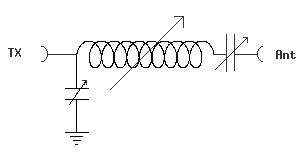Impedance matching
Jump to navigation
Jump to search
Impedance Matching is required to maximise energy transfer from an AC source to a device.
Examples:
- Transform 240V AC to 12V AC for a power supply.
- Transform a 7 Kohm audio source (from an amplifier for instance) down to 16 Ohms for a headphone or loudspeaker.
- both of these can be done by using a transformer.
- Couple an antenna with impedance other than 50 Ohm and non-zero reactance to a transceiver with 50 Ohm purely reactive impedance.
This is done by an ATU. The simplest form of an ATU consists of a variable capacitor between TRTX and ground followed by a series variable inductor, which in turn is followed by a series variable capacitor which leads to the antenna (in case of an unbalanced feed line).
| Antennas | |
| Design | Beam * Dipole * Dish or Parabola * DDRR * Log Periodic (LPDA) * Loop * Mobile and portable * Omnidirectional * Panel * Quad and Quagi * Screwdriver * Small tuned loop * Vertical * Yagi-Uda * Wire and random wire antennas |
| Installation | Antenna Tuners * Capacity hats and loading coils * Cavity filters * Coaxial Cable * Feedlines * Rotators * Towers and Masts * VK2ACY - G5RV coupler |
| Theory | Front-to-back ratio * Impedance matching * SWR * Tower design * Vertical Antenna efficiency * Wire comparison tables |
